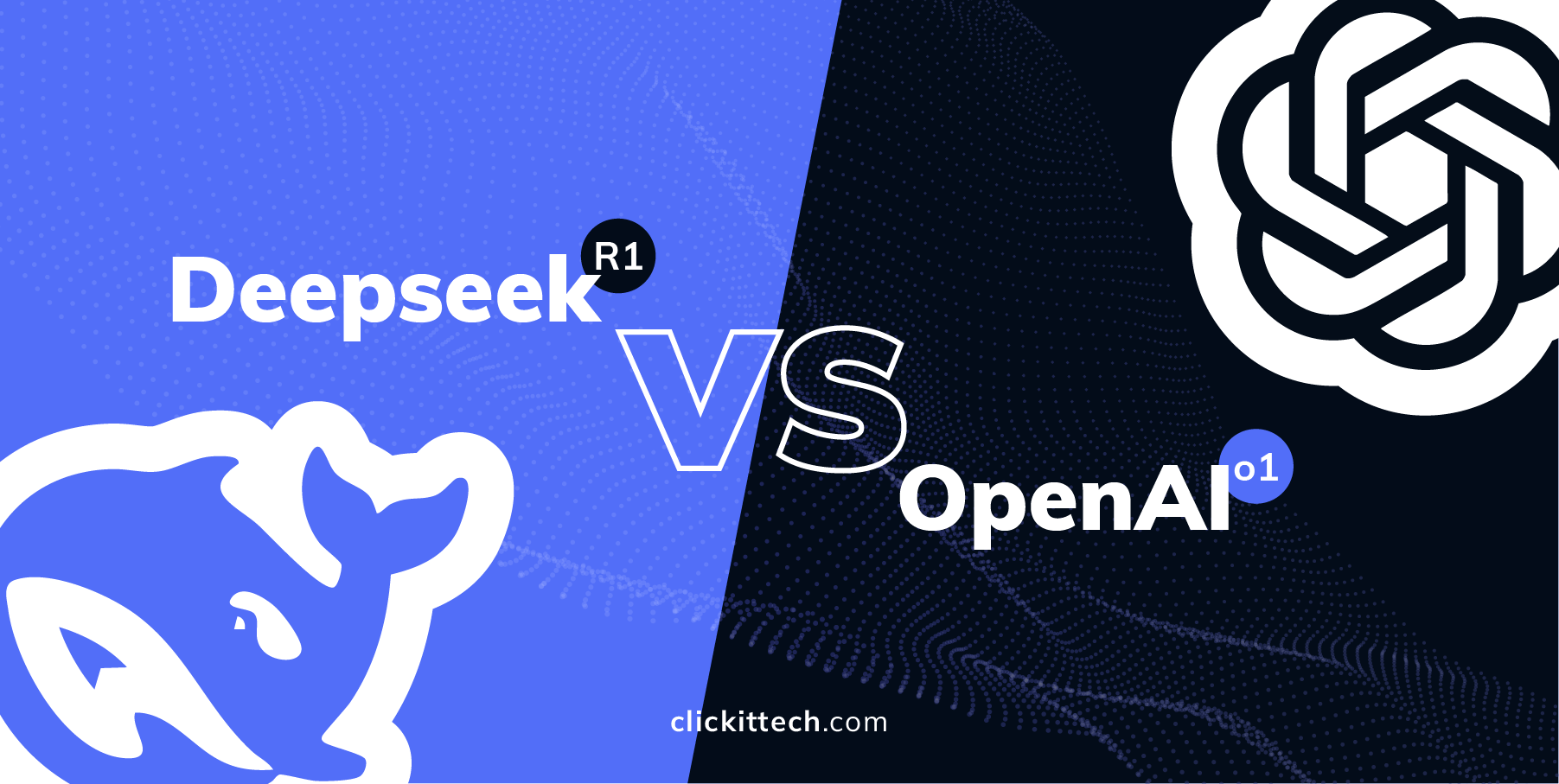There’s always something new in artificial intelligence. For the last few weeks (and possibly for the foreseeable future), the talk has been the debate between Deepseek R1 and OpenAI.
China has entered the open-weight AI race with DeepSeek. Some people claim it’s a breakthrough, and even DeepSeek itself says that its DeepSeek-R1 model outperforms OpenAI’s o1 in reasoning tasks.
Is that true, or are we buying into a hype fueled by the longstanding US-China tensions? I won’t discuss trade wars here, but you will learn the difference between OpenAI O1 and Deepseek R1.
- Overview of Deepseek R1
- What Makes DeepSeek R1 stand out from OpenAI o1?
- DeepSeek R1 vs OpenAI o1 Pricing
- DeepSeek R1 vs OpenAI o1 Pricing
- DeepSeek R1 vs OpenAI o1: Vulnerability Concerns
- Which One Is Better Between DeepSeek R1 vs OpenAI o1?
- Frequently Asked Questions About DeepSeek R1
Overview of Deepseek R1
DeepSeek R1 was officially released on January 20, 2025, and has since gained attention for delivering performance comparable to OpenAI o1—at a significantly lower cost. DeepSeek R1 is built upon the previously released DeepSeek-V3-Base variant.
It features a Mixture of Expert (MoE) architecture with 671 billion parameters, though only 37 billion are activated per operation, ensuring efficiency. The model also boasts a 128K context window and excels in Chain of Thought (CoT) reasoning, making it particularly strong in logical inference and problem-solving.
Unlike many AI models that rely on supervised fine-tuning, DeepSeek R1 was trained using reinforcement learning (RL) techniques. This approach allows it to develop advanced reasoning skills naturally, improving its performance in math, coding, and symbolic logic tasks.
Let’s Build AI-Driven Solutions Together with the best AI tools. Book a Free Call
What Makes DeepSeek R1 stand out from OpenAI o1?
Considering how OpenAI blew everyone away, you have to be very special to get attention. Turns out DeepSeek R1, the new kid on the block, could be that special thing. Here are some features that make DeepSeek R1 stand out from Open AI o1.
Open Weights & MIT License
DeepSeek R1 is fully open-source and commercially usable, allowing businesses to integrate it without licensing constraints—unlike OpenAI’s proprietary model.
Distilled Models for Efficiency
DeepSeek R1 leverages distilled models (akin to Qwen and Llama) that offer excellent performance with lower computational costs. Notably, DeepSeek’s Llama 33.7B model outperforms the o1 Mini in various benchmarks.
According to DataCamp, DeepSeek R1 performs competitively in key AI benchmarks:
- AIME 2024: 79.8% (near state-of-the-art performance), which is also slightly ahead of OpenAI o1 at 79.2%.
- MATH-500: 97.3% accuracy, slightly surpassing OpenAI o1-1217 at 96.4%.
- Codeforces (Competitive Programming): Top 3.7%, although OpenAI o1- leads with 96.6%, while DeepSeek-R1 had a very competitive 96.3%.
- MMLU (General Knowledge): 90.8% (slightly below OpenAI o1 at 91.8% but still impressive)
While OpenAI o1 leads in general language processing, DeepSeek R1 has the edge in mathematical and coding benchmarks.
One noticeable factor in our OpenAI o1 vs Deepseek R1 test is that DeepSeek R1 takes longer to generate responses than OpenAI’s model. However, thinking for longer doesn’t equal providing the most accurate answer; instead, it suggests that DeepSeek R1 prioritizes reasoning depth over response speed.
This also means that OpenAI’s model may feel more responsive and fluid for general conversational tasks, while DeepSeek R1 takes extra time to deliberate and compute its outputs.

According to this Greptile in a recent test performed, DeepSeek R1 significantly outperformed OpenAI o1 in detecting bugs and antipatterns in pull requests. Despite OpenAI’s strong reputation, it failed to catch critical issues that DeepSeek identified, such as naming problems, security vulnerabilities, and potential runtime errors.
Discover ClickIT’s AI development services to make smarter decisions
Optimized for Mathematical and Logical Reasoning
Unlike general-purpose LLMs, DeepSeek R1 focuses on step-by-step reasoning, making it particularly powerful for:
- Mathematics and symbolic logic
- Coding tasks
- Scientific and legal document analysis
- Reinforcement Learning Instead of Heavy Supervised Fine-Tuning
Additionally, DeepSeek R1’s training approach differs from traditional LLMs:
- DeepSeek-R1-Zero: Trained primarily via reinforcement learning, allowing it to improve its reasoning without human-labeled data.
- Cold Start Strategy: To counter RL-related issues (e.g., incoherence), DeepSeek introduced a small, high-quality supervised dataset to improve fluency.
Extended Context Length
DeepSeek R1 supports a 128K context window, enabling it to retain more information for tasks such as:
- Complex problem-solving
- Long-form document analysis
- Scientific and legal research
Mixture-of-Experts (MoE) for Efficient Computation
DeepSeek R1’s MoE architecture activates only a fraction of its total parameters per query, leading to:
- Lower computational costs
- Higher efficiency in reasoning tasks
- Scalability without requiring expensive hardware upgrades
One of our engineers at ClickIT commented:
“The good thing that DeepSeek did is that it promoted the creation of agents, operators, and other things that Openia has; the most common thing I’ve seen are PC controls and browser controls. Apart from that, it brought AI a little closer to people, which will increase its progress.”
DeepSeek R1 vs OpenAI o1 Pricing
Pricing is an essential factor when choosing any tool, and in the debate between DeepSeek R1 vs OpenAI o1, DeepSeek R1 is significantly cheaper.
Look at the table below for comparison.
| Model | Input Cost (per 1M tokens) | Cached Input Cost | Output Cost (per 1M tokens) |
| OpenAI o1 | $7.50 – $15.00 | $7.50 | $60.00 |
| DeepSeek R1 | $0.14 – $0.55 | $0.13 | $2.19 |
It is clear that DeepSeek R1 is 27x cheaper for input tokens and 58x cheaper for cached inputs. This pricing makes DeepSeek R1 a highly cost-effective alternative for businesses and developers.
Interestingly, though DeepSeek has not fully disclosed its development costs, its efficiency raises questions about the necessity of massive expenditures on AI hardware. This has even led to speculation about Nvidia’s stock dropping by 17%, as DeepSeek’s advancements suggest high-performance AI models may require fewer computational resources than previously thought.
We Implement the AI Tool That Works for You. Consult with Us Today!
DeepSeek R1 vs OpenAI o1: Vulnerability Concerns
According to Wiz Research, it discovered a publicly accessible ClickHouse database belonging to DeepSeek, exposing over a million log entries containing chat history, secret keys, backend details, and other sensitive information. The database, hosted at oauth2callback.deepseek.com:9000 and dev.deepseek.com:9000, was completely open, allowing full administrative control without authentication.
This security lapse meant unauthorized users could potentially access, modify, or extract critical internal data, posing a serious risk of privilege escalation within DeepSeek’s environment. Upon responsible disclosure by Wiz Research, DeepSeek promptly secured the exposure.
Read our blog to understand Oauth2 and SSO
Which One Is Better Between DeepSeek R1 vs OpenAI o1?
Both DeepSeek R1 and OpenAI o1 offer strong AI capabilities, but the better choice depends on your priorities:
- Choose OpenAI o1 if you need superior general language processing (GPQA Diamond) and a more established API ecosystem.
- Choose DeepSeek R1 if you need better mathematical reasoning (AIME 2024, MATH-500) and significantly lower costs.
DeepSeek R1 is a compelling alternative for businesses and developers looking for cost-effective, high-performance AI solutions with nearly equal performance in many benchmarks but a massive pricing advantage.
Ultimately, artificial intelligence is advancing so fast (which is interesting to see), and DeepSeek R1’s open-weight approach could accelerate AI adoption globally. Whether it will challenge OpenAI’s dominance in the long run remains to be seen, but for now, it presents a powerful and budget-friendly alternative.
Deep Learning with OpenAI or DeepSeek R1? Our Engineers Can Help
Frequently Asked Questions About DeepSeek R1
Yes, since DeepSeek-R1 is open-source, it can be fine-tuned for specialized tasks, provided you have the necessary computational resources and training data. This makes it an attractive option for researchers and businesses looking to develop industry-specific AI solutions.
Yes, the maximum output length depends on how you access the model. For instance, the deepseek-reasoner API supports up to 8,000 tokens, which includes both intermediate reasoning steps (Chain-of-Thought) and the final response.
DeepSeek-R1 is significantly cheaper than OpenAI models. Its pricing structure makes it an attractive alternative, especially for businesses and developers handling large-scale AI workloads. While OpenAI charges $7.50–$15 per million input tokens and $60 per million output tokens, DeepSeek’s rates are as low as $0.14 per million input tokens and $2.19 per million output tokens, making it a far more affordable choice.
Yes, DeepSeek was founded in 2023 by Liang Wenfeng in Hangzhou, China. The model was initially trained on Nvidia A100 chips, and despite the U.S. export restrictions on these chips, DeepSeek continued its development. On January 20, 2025, the company officially launched DeepSeek R1, a model that competes directly with OpenAI’s o1 in performance.









